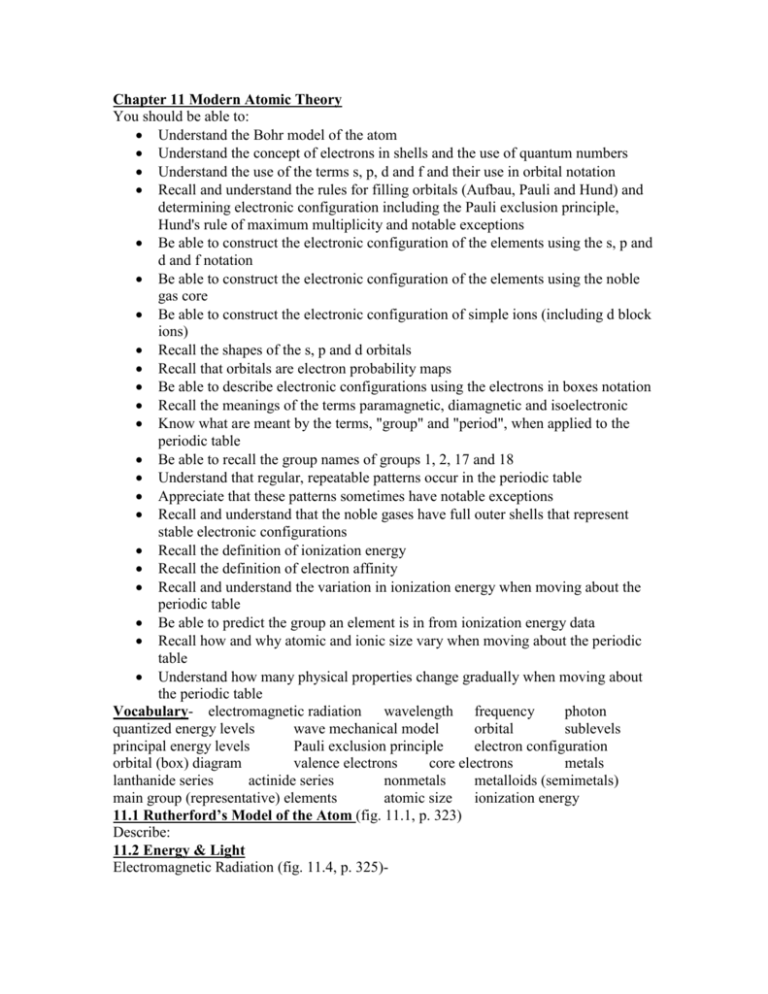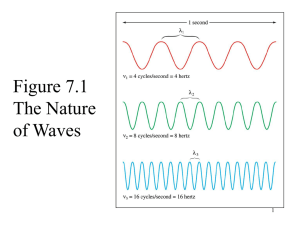Chapter 11 Modern Atomic Theory
advertisement

Chapter 11 Modern Atomic Theory You should be able to: Understand the Bohr model of the atom Understand the concept of electrons in shells and the use of quantum numbers Understand the use of the terms s, p, d and f and their use in orbital notation Recall and understand the rules for filling orbitals (Aufbau, Pauli and Hund) and determining electronic configuration including the Pauli exclusion principle, Hund's rule of maximum multiplicity and notable exceptions Be able to construct the electronic configuration of the elements using the s, p and d and f notation Be able to construct the electronic configuration of the elements using the noble gas core Be able to construct the electronic configuration of simple ions (including d block ions) Recall the shapes of the s, p and d orbitals Recall that orbitals are electron probability maps Be able to describe electronic configurations using the electrons in boxes notation Recall the meanings of the terms paramagnetic, diamagnetic and isoelectronic Know what are meant by the terms, "group" and "period", when applied to the periodic table Be able to recall the group names of groups 1, 2, 17 and 18 Understand that regular, repeatable patterns occur in the periodic table Appreciate that these patterns sometimes have notable exceptions Recall and understand that the noble gases have full outer shells that represent stable electronic configurations Recall the definition of ionization energy Recall the definition of electron affinity Recall and understand the variation in ionization energy when moving about the periodic table Be able to predict the group an element is in from ionization energy data Recall how and why atomic and ionic size vary when moving about the periodic table Understand how many physical properties change gradually when moving about the periodic table Vocabulary- electromagnetic radiation wavelength frequency photon quantized energy levels wave mechanical model orbital sublevels principal energy levels Pauli exclusion principle electron configuration orbital (box) diagram valence electrons core electrons metals lanthanide series actinide series nonmetals metalloids (semimetals) main group (representative) elements atomic size ionization energy 11.1 Rutherford’s Model of the Atom (fig. 11.1, p. 323) Describe: 11.2 Energy & Light Electromagnetic Radiation (fig. 11.4, p. 325)- Draw fig. 11.3, p. 324 Draw fig. 11.4, p. 325 WavelengthFrequencySpeed of lightPhotons11.3 Emission of Energy by Atoms Excited stateGround state A quantum package of light is emitted when an electron loses energy and goes from an excited state to a less excited state (maybe all the way down to its ground state). Draw fig. 11.8 11.4 The Energy Levels of Hydrogen Different wavelengths of light carry different amounts of energy per photon Red light- less energy Blue light- more energy Draw fig. 11.10, p. 328. Energy levels are quantized- only certain energy levels are allowed. Why? 11.5 The Bohr Model of the Atom Niels Bohr- Bohr model of atom (only really works for Hydrogen. Why?) Electrons are not really in circular orbits around the nucleus (even though it is convenient to draw them this way) Draw fig. 11.17, p. 329 11.6 The Wave-Mechanical Model of the Atom E. Schrodinger & L.V. de BroglieWave-mechanical model-Electrons can behave with wave properties OrbitalHeisenberg Uncertainty Principle- 11.7 The Hydrogen Orbitals Principal Energy Levels- 1, 2, 3, … (fig. 11.21, p. 334) Sublevels1st principal energy level has 1 sublevel 2nd principal energy level has 2 sublevels 3rd principal energy level has 3 sublevels, etc. The first sublevel is always designated _____ The second is designated_____; The third is designated _____;The Fourth is designated _____. (no need for any more…)(why?) s has 1 orbital; p has ___ orbitals; d has ___ orbitals; f has ___ orbitals. (see figures 11.24, 11.25, 11.26, 11.27, and 11.28, p. 334-336) Shape of s shapes of p shapes of d 11.8 The Wave Mechanical Model: Further Development Pauli Exclusion Principle- Aufbau Filling Order1s2 2s2 2p6 3s2 3p6 ** 4s2 3d10 4p6 5s2 4d10 5p6 6s2 4f14 5d10 6p6 7s2 5f14 6d10 7p6 ** overlap occurs Example: True or False? _____ an s orbital is always spherical in shape _____ the 2s orbital is the same size as the 3s orbital _____ the number of lobes on a p orbital increases as n increases; that is, a 3p orbital has more lobes than a 2p orbital _____ level 1 has one s orbital; level 2 has two s orbital; level 3 has three s orbitals, and so on. _____ the electron path is indicated by the surface of the orbital 11.9 Electron Arrangements in the First Eighteen Atoms on the Periodic Table Hund’s Rule(see Carbon, Chromium, and Copper) Element At # #p #e elec conf orbital diagram H at. #1 1p 1e1s1 He at. #2 2p 2e1s2 Li at. #3 3p 3e1s22s1 Be B C N O F Ne Na Mg Al Si P S Cl Ar Valence electronsCore (noble gas inner core) electronsKernel & shorthand elec. configuration Elements in same vertical group have same # of valence electrons (see the periodic table we marked up) Orbital DiagramsAn orbital is a box; an electron is represented by an arrow, one up and one down (indicates opposite spins). No more than 2 arrows can be in a box. S orbital has 1 box; p has 3; d has 5; f has 7. Example 11.2,, p. 342- write the complete electron configurations and orbital diagrams for elements aluminum through argon.(do above in the table under 11.9) 11.10 Electron Configurations and the Periodic Table K Ca Cr (expected) Cr (actual) Cu (expected) Cu (actual) Lanthanide series Actinide series 11.11 Atomic Properties & the Periodic Table MetalsNonmetalsMetalloids (semimetals)Atomic size- size of atoms generally decrease as you go across the period from left to right (increasing atomic number)(increased # of protons draws electrons in tighter) Atomic size generally increases as you go down a vertical group. (higher principal energy levels are further from the nucleus)(fig. 11.36, p. 350) Ionization Energy- amount of energy needed to remove an electron from an atom of the element in the gaseous state. (p. 352)(see charts/graphs in class) (successive ionization energies)







